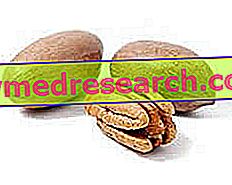Generality
Pecan nuts are plant foods in the dried fruit group. They have a high energy value but also an excellent concentration of essential fats; the taste is rich and buttery.

Pecan nuts are the fruit of a plant native to the United States of America and their trade in Italy is mainly supported by imports. The Pecan nut tree belongs to the Junglandaceae family, Genus Carya, Specie illinoensis ; the binomial nomenclature of the plant is therefore Carya illinoensis . NB . Pecan nuts are known for different varieties.
The wood of the tree is used as a fuel or flavoring for smoked meats. The term "Pecan" is of algonquian origin (American Indians) and literally means "hazel that requires a stone to be broken".
Description
Aesthetically, Pecan nuts look similar to traditional Italian walnut. Being drupes, they consist of an epicarp, a mesocarp and an endocarp enveloping the seed (edible part). The epicarp and the mesocarp are fleshy (3-4mm), but less thick than the traditional walnut; the epicarp is first green and then brown.

The Pecan tree is large; specimens that reach 40m in height and 2m in diameter are not rare on the trunk, and some more than 50m in height seem to have been identified (but there is no documented evidence). The leaves are ellipsoidal, 30-45cm, green and deciduous. Pecan nut trees have both male and female flowers, and pollination occurs mainly by wind. Pecan nuts reach full maturity in autumn, more precisely in October.
Plants are particularly long-lived and live up to 300 years.
Origins and cultivation
Pecan nuts are typical fruits of the United States, especially in the central-southern area, and in Mexico. To be precise, the presence of the Carya illinoensis tree is most dense in: Arkansas, Florida, Georgia, Illinois, Indiana, Iowa, Kentucky, Louisiana, Mississippi, Missouri, Oklahoma, South Carolina, Tennessee, Texas, and from Coahulia south to Jalisco and Veracruz.
The cultivation of the tree for the production of Pecan nuts is not ancient. It seems to have begun only in 1880 in the USA, a country that boasts an annual productivity of up to 80-95% of the world total (150, 000-200, 000 tons per year for 10, 000, 000 trees). Other cultivation areas are located in South America, China, Australia, South Africa and Israel; in Italy there are small plots of Pecan nuts in the Sicily region.
| Composition for: 100g of Pecan Nuts - Reference values of the INRAN Food Composition Tables | ||||||||||||||||||||||||||||||||||||||||||||||||||||||||||||||||||||||||||||||||||||||||||||||||||||||||||||||||||||||||||||||||||||||||||||
 | ||||||||||||||||||||||||||||||||||||||||||||||||||||||||||||||||||||||||||||||||||||||||||||||||||||||||||||||||||||||||||||||||||||||||||||
Nutritional values (per 100 g of edible portion)
| ||||||||||||||||||||||||||||||||||||||||||||||||||||||||||||||||||||||||||||||||||||||||||||||||||||||||||||||||||||||||||||||||||||||||||||
The cultivars are essentially composed of "clones", which is why it is necessary that some of these come from different trees, since (unlike those born from seed) these are not able to self-pollinate and require genetically foreign specimens for fertilization. NB . The Pecan nut tree is prone to nickel deficiency.
Gastronomic uses and nutritional properties
Pecans can be eaten on their own or in elaborate dishes. In the USA, Pecan nut cake is a national dish and small praline snacks (candies) are typical of the city of New Orleans. In Italian cuisine, Pecans are not widely used, but their use is similar to that of traditional walnuts. NB . The " Lazy Magnolia Brewing Company in Kiln, Mississippi " produced a pecan-flavored beer instead of hop.
Pecan nuts are a food that lends itself to fighting hypercholesterolemia and oxidative stress. The high percentage of polyunsaturated fatty acids, phytosterols, vit. E (α-tocopherol) and phenolic substances (flavonoids) determines the reduction of total and "bad" cholesterol (LDL), as well as the predisposition to tumors.
Research conducted by the University of Massachusetts and published in " Current Topics in Nutraceutical Research " has shown that regular consumption of Pecan nuts can also reduce neuromuscular degeneration linked to aging; a sort of anti-aging effect.
It has also been hypothesized that, in the presence of other predisposing factors, a diet rich in pecan nuts may reduce the risk of lithiasis in women.
In addition to fat, Pecan nuts are also rich in dietary fiber, a nutritional element that protects the integrity and functionality of the intestine. From the saline point of view, these products abound in iron and potassium, while as far as vitamins (in addition to tocopherols) are concerned, significant amounts of thiamine appear.
Despite the various positive aspects, we recall that Pecan nuts are remarkably caloric foods; consequently their use - to be considered QUANTITATIVELY marginal - should be limited to a few grams per day.



